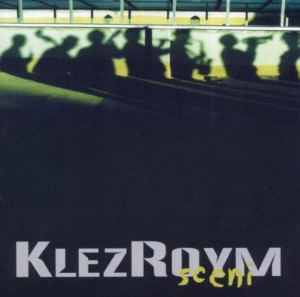 Brendan Foreman wrote this review.
Brendan Foreman wrote this review.
This is a lesson that I find myself learning over and over again: Never, ever underestimate humanity’s ability to reconfigure venerable art forms into new, often strange objects. Just when I thought I had klezmer pretty much pegged as a musical form, KlezRoym’s Sceni comes in the mail.
KlezRoym is a band out of Italy who combine the fervor and stylings of klezmer with the improvisation of Roma jazz and the feel of Mediterranean music. Sure, all klezmer, being the hybrid genre that it is, has a little Roma, a little jazz, and maybe a little Mediterranean harmony. But KlezRoym, a seven-person unit consisting of Gabriele Coen, Andrea Pandolfo, Pasquale Laino, Riccardo Manzi, Marco Camboni, Leonardo Cesari, and Eva Coen, add their own mixture of moxy, imagination, and excellent improvisational skills to the music. The absence of any fiddles or clarinets and the emphasis on saxophones, bouzoukis, and trumpets give the music of KlezRoym a distinctly forthright, sultry sound.
From the beginning track, “Trokar Kazal, Trokar Mazal (Change Country, Change Fate),” a Latin-flavored song about a Spanish exile pining for his homeland, we know we’re in for a treat. Eva Coen’s singing is simultaneously sensual and mournful, which is echoed in the plaintive saxophones and trumpet of Gabriele Coen, Pasquale Laino, and Andrea Pandolfo. The song meanders into an extended instrumental, the arrangement of which easily recalls some of the 3 Mustaphas 3’s best work.
This is just the beginning — literally. From here, KlezRoym prove how little they can sit still, moving from the ska-flavored klezmer of “To East,” which ends with a wonderfully discordant guitar solo, to the melancholy Italian love song “Canzone Dell’Amour Perduto (Song of Lost Love),” written by Fabrizio De Andre, then onto the Jewish-Hungarian hora “Szol A Kakas Mar (And the Cock Crow).”
Interspersed between many of these tracks are snippets of “Radio Freylachs.” A “freylach” (meaning “joy” in Yiddish) is a standard melody form in klezmer, like the czardas in Hungarian music and the jig in the music from the Isles. The half-minute freylachs that KlezRoym uses here to introduce their tracks are all traditional tunes, which they’ve recorded in mono, giving them an “old-time radio” sound.
Guitarist and bouzouki player Riccardo Manzi gets to stretch his vocal chords in “Arum Dem Fayer (Around the Campfire).” Its haunting melody runs counter to the gaiety of the lyrics about the travelingm life of song and dance. This ends abruptly to the klezmer and jazz hybrid sounds of the title track “Sceni, Sceni.” Rather than just the almost standard sounds of Gypsy jazz that is often found within klezmer, one can also hear some strains of the cool jazz that was pioneered by Miles Davis back in the late ’50’s.
KlezRoym fills the rest of the CD with just as various a selection of music from the dirge-like “Nostalgia,” which is immediately lightened up by the up-beat jazz improv of “Regalo Di Nozze,” to “Klezmer Song,” KlezRoym’s own celebration of klezmer music, and the foreboding Sephardic folk song, “Morenica.” The CD “officially” ends with the lullaby “Oyfn Pripetshik (At The Fireplace),” a popular children’s song that prisoners of the death camps of Europe would often sing to each other and thus has become a symbol of the Shoah.
Rather strangely, there are two bonus tracks, house versions of “Morenica” and “Oyfn Pripetshek.” They’re a bit of a shock after the traditional sounds of the previous tracks, but they are a transition back to more modern sounds.
There really is no way any self-respecting klezmer or Gypsy jazz lover would want to miss this CD. Actually, anyone with a passing interest in traditional European music will find plenty to enjoy on Sceni.
(CNI, 2000)
